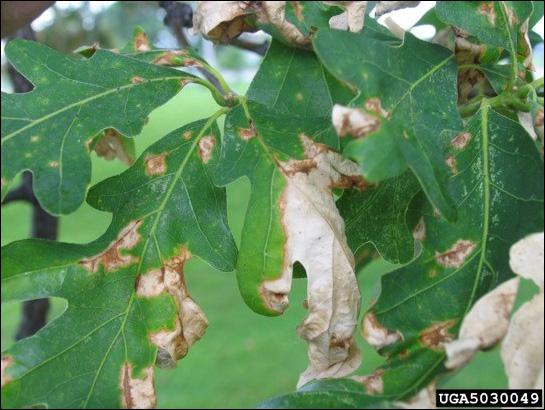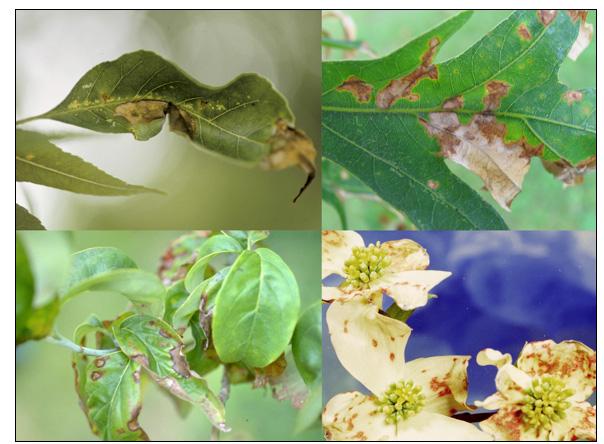Plant Health: Anthracnose
By Dr. Ellen Crocker
After a long hard winter, the Bluegrass is ready for summer! Trees are leafed out, flowers are blooming and our urban forests have woken up from a long nap. However, unwelcomed disease symptoms are already creeping in. Have you noticed spots or distorted growths on the leaves of your deciduous trees and shrubs?

Seeing this? Your tree might have Anthracnose…
You may be seeing the signs of an Anthracnose disease. Symptoms, including irregular brown spots or blotches on leaves, leaf distortion (curling, crumpling, etc.), pop up in the spring on ashes, oaks, maples, walnuts, buckeyes, dogwoods and more.

Anthracnose on different hosts: ash (top left), oak (top right), dogwood leaves (bottom left) and dogwood flowers (bottom right)
What causes Anthracnose disease?
Anthracnose is caused by a number of different species of fungi. The exact culprit depends on the particular plant species infected, however all of these fungi are closely related and cause similar symptoms.
How did it get here?
The fungi that cause Anthracnose overwinter in infected plant material, waiting for cool spring rainy periods to produce infectious spores and infiltrate leaves. Because the fungus needs cool wet weather to infect leaves, warm and dry years may result in few symptoms. However, the pathogen will just wait around until the conditions are right.
Which plants are infected?
Anthracnose diseases can infect many different hosts, but symptoms vary by plant species. Some (such as ash and yellow-poplar) only get leaf spots. Others (like oak and sycamore) might show symptoms on leaves, twigs, buds and shoots. Not all leaf spots, however, are Anthracnose. If you are wondering about the leaf spots and browning on your evergreen plants, the hard winter might be to blame instead…
What should I do about it?
Anthracnose diseases may look unsightly, in some severe cases it can lead to leaf drop, tree stress and lack of new growth. However, the good news is that in most cases the damage Anthracnose causes is tolerable. There are a few options to minimize Anthracnose problems:
- Discourage infection: Management practices that increase airflow around the tree and its leaves will reduce rates of infection, as the fungus likes moisture.
- Clean up: Infected plant material can be removed (rake leaves, prune infected branches and twigs in the winter) so that there is less infectious material around in the spring to reach healthy plants.
- Increase tree vigor: Healthy trees are less susceptible to anthracnose and less likely to be negatively affected by it. Because of this, good management practices (ex. addition of fertilizer, winter pruning, proactively planting trees in the right place, appropriate mulching, preventing drought damage) are also going to help with anthracnose.
- Fungicide treatment: Because the effects of Anthracnose disease are generally minimal, fungicide usually is not needed. But, if you really would like to protect a high value tree or are having severe problems, year after year, there are several fungicide treatment options and you can call your local extension office for a listing of recommended fungicides. Keep in mind, however, that fungicides should be applied carefully and consider enlisting the services of a professional. In addition application should occur before symptoms appear and should be repeated regularly as recommended.
Photography
- Anthracnose on white oak leaves (Joseph O’Brien, USDA Forest Service) Bugwood.org
- Various tree species with anthracnose; Ash and oak: Joseph O’Brien, USDA Forest Service. Dogwood leaves: John Hartman, University of Kentucky. Dogwood flowers: Clemson University- USDA Cooperative Extension Slide Series. All photos from Bugwood.org
About the Author
Dr. Ellen Crocker is an Assistant Professor of Forest Health Extension in the Department of Forestry and Natural Resources at the University of Kentucky. Her background is in plant pathology and her current focus is on education and outreach related to forest health issues such as invasive plants, insects and pathogens. She is particularly interested in new ways to engage people about the health of their trees, including the development of the HealthyWoods app to assist landowners in assessing and improving their woods. In addition, she conducts a range of applied research related to forest health and the management of invasive species. Email @ e.crocker@uky.edu
